Alien Invaders
© Tom Hibbert
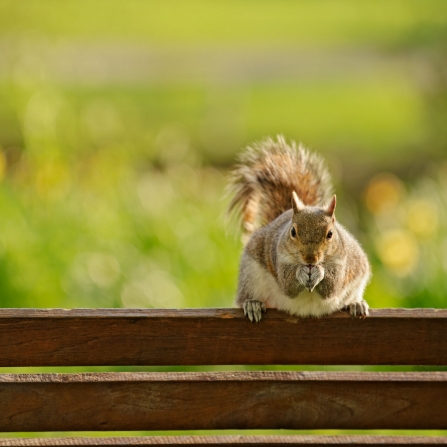
Grey Squirrel © Terry Whittaker/2020VISION
It is possibly one of the most familiar mammals and many people will feel fairly positive towards grey squirrels for they provide easy wildlife encounters. Native to North America, the grey squirrel was introduced to Britain in the 1870s as a fashionable addition to large country estates. It has taken to our climate and has spread quickly so that by 1937, it had become illegal to import and keep them.
The grey squirrel outcompetes our native red squirrel because of its breeding cycle – a female grey can have two litters per year – and because it can carry squirrel pox to which red squirrels are highly vulnerable. By now, the grey squirrel has successfully driven red squirrels out of Hertfordshire and most parts of England with only a few isolated populations of reds left in the North and the Isle of Wight.
Himalayan balsam
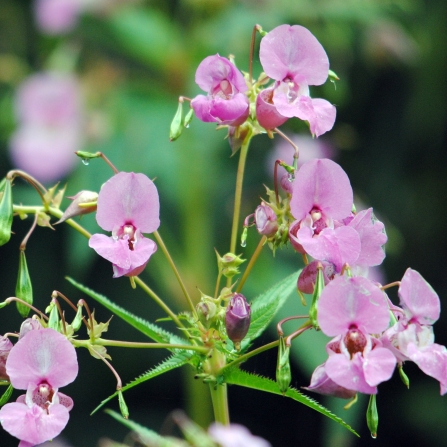
Himalayan balsam © Amy Lewis
As its name suggests, Himalayan balsam is native to the Himalayas and was introduced to the country in 1839 as a garden plant from which it escaped within decades, quickly becoming one of the most invasive weeds. It’s posing a serious threat to riverbank flora but is spreading further towards road verges and damp woodlands.
It’s pretty pink nectar-rich flowers are said to have contributed to its spread, as it’s attractive to both people and bees. Wherever Himalayan balsam can get a foothold, it outcompetes native flora by overshadowing and smothering it. An annual plant, it grows up to 10 feet within a single year, then dies down in winter leaving riverbanks bare. Exploding seed pods catapult the seeds up to 22 feet away, which then stick to shoes and car tyres, spreading the weed even further.
It is now a legal requirement for landowners to tackle Himalayan balsam on their land, so every summer, Herts and Middlesex Wildlife Trust organises “balsam bashing parties” to try to free its nature reserves from the invader. The Trust has also come up with an idea to approach this problem: In a partnership with Tring-based Puddingstone Distillery, it produces the world’s first Himalayan balsam-induced pink gin. After all, all part of the plant are edible, so we might just eat and drink our way out of this.
Harlequin ladybird
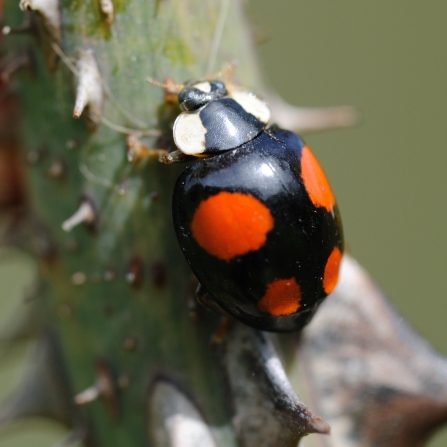
Harlequin Ladybird © Amy Lewis
There are nearly 50 different native ladybird species in Britain, 26 of which look like the classic round, spotty ladybird that is so familiar to us. This makes the Harlequin ladybird a rather inconspicuous invader – it’s difficult to distinguish them from our native British ladybirds. It is, however, said to be the UK’s fastest-invading non-native species. Only introduced to the country in 2004 as pest control for aphids, the Harlequin ladybird has since spread all over the south-east of England.
They’re here to stay – the Harlequin ladybird has become fully established here and it is difficult to control populations without harming other wildlife. While they do compete with native ladybirds for food – and readily turn to eat them – it is suggested that native insects may now have adapted to prey on the harlequins, helping to keep numbers in check.
Muntjac deer
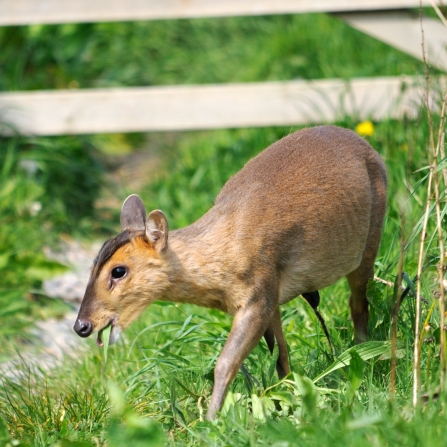
Muntjac deer © Amy Lewis
Not much bigger than a dog, this non-native deer is a common sight in Hertfordshire’s woodlands, parklands and even gardens. It has quickly gained a stronghold across South East England after being introduced to Woburn Park in Bedfordshire at the start of the 20th century.
Native to South-east China, muntjacs are notorious browsers, eating the shoots from shrubs as well as woodland herbs and brambles – in high density, they can cause significant damage to the local flora. Like other deer species in the country, muntjacs are thriving due to a lack of natural predators such as lynx, wolfs and bears that would have controlled populations hundreds of years ago.
Japanese knotweed
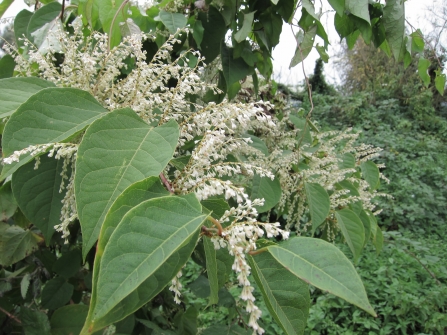
Japanese knotweed © Tim Hill
If you have ever dealt with Japanese knotweed as a home-owner or prospective buyer then you will know the problems associated with this weed. Unbeknownst to the impact it would have on the ecosystem and infrastructure, it was brought to the country in the 19th century as an ornamental plant and potentially to stabilise railway banks. Japanese knotweed can crack tarmac, block drains, undermine foundations and invade homes. With no natural enemies in this country, it is incredibly difficult to get rid of. It grows faster than Himalayan balsam and its roots can spread underground. Getting rid of it is an expensive task that needs special expertise. Simply cutting won’t cut it, as even tiny amounts of roots can regrow into a full plant.
American mink
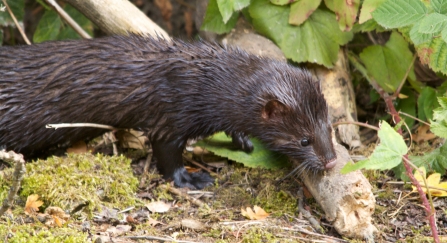
© Tom Hibbert
Escaped from fur farms in the 1950s and 60s, the American mink is one of the biggest threats to our native water vole which is now the fastest-declining mammal in the UK. Minks are fierce predators, feeding on anything that is big enough to catch, including ground-nesting birds and water voles, with devastating impacts on biodiversity. They are good swimmers which can easily enter the water vole’s underground burrows taking their young.
Canada goose
Canada goose © Josh Kubale
The Canada goose is our largest goose and maybe our most familiar. They are common across most of the country. As the name suggests, they are not native to this country, having been introduced from North America about 300 years ago. Canada geese are happily nesting on park lakes, flooded gravel pits and reservoirs, not particularly avoiding human settlement which can cause nuisance and pollution in towns and cities. In the wild, Canada geese can have an impact on the nesting behaviour of native wildfowl, as they outcompete them for breeding grounds.
Spanish bluebell
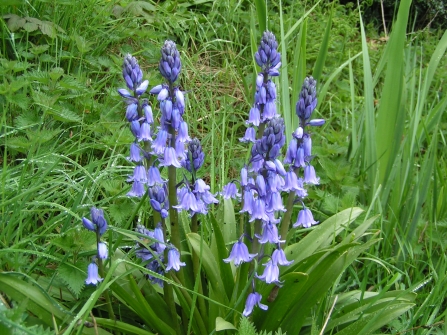
Spanish bluebells © Richard Burkmar
Almost half of the world's bluebells are found in the UK, but our native favourite blue flower is being outcompeted by a Spanish invader. The Spanish bluebell is said to be a garden escapee from the 19th century and is now widespread across the country. Compared to its English cousin, the Spanish bluebell is much more robust and can spread quicker. English bluebells are very delicate and it can take years for them to become established. There are now many hybrids between these two, so an unambiguous identification may prove difficult. Generally, our English native has bell-shaped flowers with a more drooping stem. Spanish bluebells in your garden are not necessarily a reason to worry – unless you live close to woodlands – but it’s important to keep an eye on them so that they don’t spread uncontrollably.
Signal crayfish
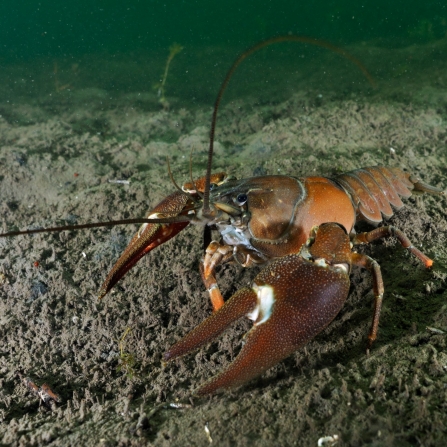
Signal Crayfish © Linda Pitkin/2020VISION
After the crayfish plague had ravaged native crayfish populations in the 1970s, the government introduced the signal crayfish as seafood, not knowing that this species itself is a carrier for the very crayfish plague. Our native white-clawed crayfish has suffered a huge decline since, being outcompeted for food and habitat as well as not being immune to the crayfish plague. The signal crayfish builds burrows in riverbanks causing erosion leading to destabilised riverbanks, increased flood risk and silted waters. So far, control attempts have been unsuccessful, so the strategy is to control populations by making sure the crayfish plague isn’t being introduced to new waterways.
Ring-necked parakeet
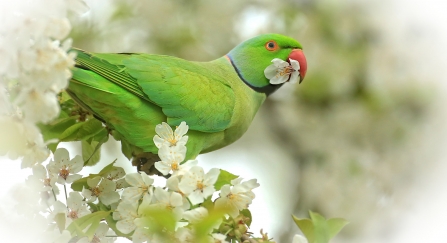
Ring-necked parakeet © Jon Hawkins - Surrey Hills Photography
Among the muted plumage of many of our native birds, the ring-necked parakeet is probably the most exotic invader. It is native to central and South Africa and Asia, but its origins in our area are a bit more mystical – rumour has it that birds were released from film studios in Middlesex after filming The African Queen in the 1950s. Fact is that it is now thriving in London and throughout the Home Counties, seemingly preferring the urban jungle. While it has been spreading fast, its threat to native wildlife hasn’t yet been established, but conservation organisations are carefully monitoring numbers and their impact.
What we do
Together with volunteers and supporters, the Trust tackles non-native invasive species on our reserves and in the wider countryside to protect our valuable native wildlife.

